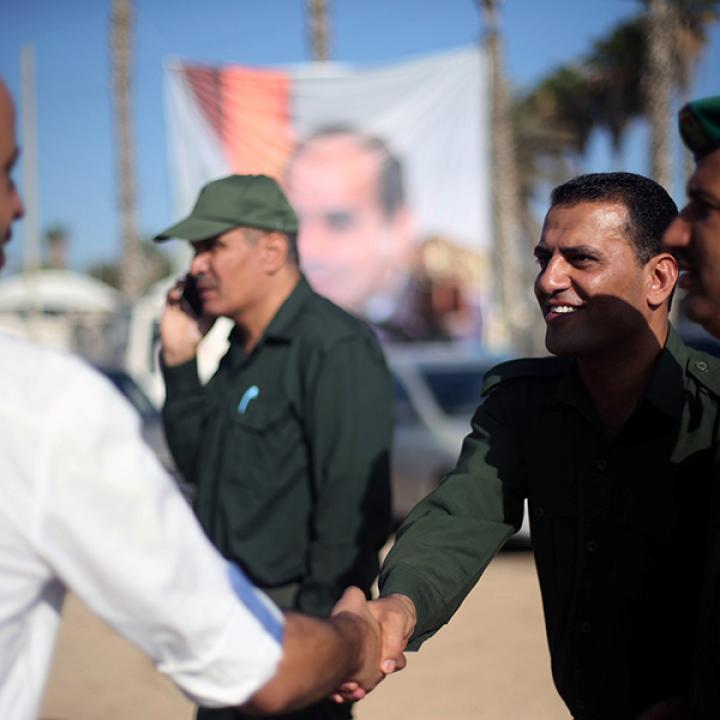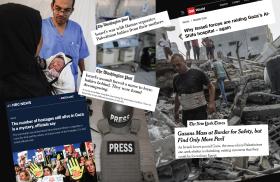

Israel and Hamas cannot advance their current strategic goals through intensified fighting, but the Cairo dialogue could enable important short-term gains in Gaza.
This PolicyWatch is the second in a two-part series on the latest hostilities between Israel and Hamas. Part 1 discussed the domestic political implications for Israel.
After seven months of ongoing clashes, and before the recent escalation in Gaza, Israel and Hamas were making significant progress in Egyptian-sponsored talks aimed at reaching limited ceasefire understandings. Resuming those discussions and implementing the understandings seems like their best available course of action today, despite the current volatility.
The talks turned fruitful when they finally disaggregated the myriad demands made by both sides, adopting a piecemeal approach instead of bundling. The main goal is to produce a limited but concrete set of arrangements whereby Hamas commits to end violence against Israel (including confrontations along the Gaza security barrier during weekly “Marches of Return,” as well as incendiary kite and balloon attacks), while Israel allows foreign assistance into Gaza to alleviate the territory’s pressing economic and humanitarian situation.
Before the latest escalation, both sides took steps to signal their seriousness and goodwill. Israel allowed the immediate transfer of $15 million to pay the salaries of Hamas employees in Gaza as part of a $90 million grant from Qatar. It also permitted the entry of fuel trucks. For its part, Hamas ensured that the November 2 and 9 border marches avoided friction with Israeli forces, producing two of the calmest Fridays since the practice began in March.
A TACTICAL SETBACK
The latest escalation stemmed from a tactical development, not from either side’s strategic intent. On November 11, a covert Israel Defense Forces team operating deep in Khan Yunis was exposed and exchanged fire with Hamas forces, resulting in the deaths of one senior IDF officer and seven Hamas operatives. This was followed by fierce cross-border fighting, the worst since 2014. Israeli towns were targeted with around 500 rockets and mortars, which scored some direct hits on homes and other buildings while spurring close to 100 intercepts by Iron Dome defense batteries. One civilian was killed and several others wounded in Israel. In Gaza, the IDF struck 160 targets; five Palestinians were reported killed.
Soon afterward, however, both sides decided to pull back from the brink. The Israeli cabinet accepted the defense establishment’s recommendation and agreed to another Egyptian-proposed ceasefire, seeing no gains in further escalation. Hamas declared victory but nevertheless kept its November 16 border march from spiraling into violence.
DIVIDING, NOT BUNDLING
Disaggregation was the key to the last round of talks because bundling numerous agenda items had bogged down previous efforts. By attempting to tackle a wide swath of issues at once—security conduct, wages, fuel, commercial traffic, intra-Palestinian reconciliation, prisoners, disarmament, and large infrastructure projects—negotiators had increased the complexity of each item and created room for more actors to derail the process.
On the Palestinian front, Egypt initially sought to reconcile the Palestinian Authority and Hamas. The idea was to bring the PA back to Gaza before pursuing a truce with Israel, both to bolster the PA’s standing and to deny Hamas political credit. International donors supported this approach as a matter of diplomatic and practical preference. Since many governments have formally designated Hamas as a terrorist organization, reaching a Gaza truce without the PA would complicate assistance efforts in the struggling territory. Donors would have to go through cumbersome procedures to ensure that aid completely bypasses Hamas and is not used for terrorist or military purposes.
Yet reconciliation talks stalled after PA president Mahmoud Abbas demanded that Hamas disarm immediately, and the situation began to deteriorate sharply due to sanctions he imposed on Gaza. Some believe that these pressure tactics were part of a deliberate effort by Abbas to precipitate conflict between Hamas and Israel. In any case, while his concerns regarding Hamas arms were legitimate and shared as an ultimate goal by Egypt and Israel, his insistence made him a spoiler in the urgent context of stabilizing Gaza and avoiding escalation.
As a result, Egypt—with the support of international donors and Israel—opted to pursue a Gaza truce independent of its Palestinian unity discussions. The aim was not to seek a direct Hamas-Israel agreement, but rather to broker a set of understandings between them while sidelining the PA during the negotiations and initial implementation. Working through the UN, international donors are already in the process of setting up a funding mechanism that bypasses the PA and Hamas. Meanwhile, the various components of the wider understandings are being phased in gradually to create ongoing momentum.
To achieve this result, Egypt also had to make some adjustments of its own, especially regarding the role of Qatar. Tensions between Cairo and Doha are longstanding, and Gaza has been one arena where they played out. Hamas political leader Khaled Mashal and his Qatar hosts were a serious hindrance to reaching a ceasefire during the 2014 Gaza war, contributing to the conflict’s unprecedented length. Yet once it became clear that Qatar was—at least for the time being—the only country willing to immediately allocate funds for the Gaza stabilization plan, Egypt took the pragmatic path of allowing Doha to participate.
VULNERABILITIES
While disaggregation has produced progress, it left some actors feeling that their interests were unmet, thereby motivating them to play a spoiler’s role. For example, Abbas may have been pressured to acquiesce to Egypt’s approach, but if past experience is any guide, his continued cooperation is far from guaranteed. As the PA becomes increasingly marginalized, he may choose to act on his threat to cut all PA payments to Gaza, plunging the territory into a deeper humanitarian crisis that could quickly sharpen its security threats.
Such a move would test the resolve of Israel and international donors. Israel could opt to divert some of the value-added tax (VAT) clearances it collects on the PA’s behalf into Gaza, and donors could do the same with their aid. Yet such a course of action could have implications for West Bank stability, perhaps including PA security cooperation with Israel.
Local Gaza actors could derail the process as well. Under new leadership, Palestinian Islamic Jihad has been reenergizing its relations with Iran and reasserting its presence, firing rockets into Israel on October 26 in a strike that was not coordinated with Hamas. Moreover, some constituencies within Hamas are not satisfied with the ceasefire arrangements. Some hardline elements see them as an unacceptable concession to Israel, while others are unhappy with the group’s implied reorientation away from the Muslim Brotherhood orbit of Qatar/Turkey and toward Egypt. Keeping PIJ and rogue Hamas elements under control will test the limits of the organization’s leadership as they try to fulfill their end of the bargain in Gaza.
Besides intentional spoilers, tactical developments may dictate their own escalatory logic, as occurred in the latest round of fighting. As Hamas promoted popular assaults on Israel’s border and at sea over the past seven months, several uncontrolled attacks were conducted by individual elements in Gaza, and two rockets were launched inadvertently, perhaps due to technical failure. These tactical sparks could flare up into unintended escalation.
Alternatively, Hamas may try to walk the tightrope of controlled violence for domestic gains, allowing its current sense of victory over triggering Israel’s political crisis to balloon into hubris and tactical adventurism. Israel may likewise find it more difficult to walk back from the brink if the current political turbulence persists. Although the prospect of early elections seems to have dissipated for the moment, the public’s very negative reaction to the government’s handling of recent clashes could erode Israel’s restraint in a future flare-up.
CONCLUSION
Continuing the truce process and implementing its understandings seem like the best means of preventing a pointless confrontation in Gaza and stabilizing the territory’s humanitarian situation. Accordingly, the United States should encourage the parties as they seek to reach practical understandings and promote calm. It should also signal support for Egypt’s efforts to stabilize Gaza and encourage a positive role for the PA in these efforts, as much as it is willing to play. At the same time, Washington can prepare for future obstacles, readying donors to step in if Abbas again cuts Gaza’s budget and, later, building on available momentum by leveraging the administration’s own peace plan to further stabilize the theater through economic and infrastructure improvements.
Ghaith al-Omari is a senior fellow at The Washington Institute and coauthor of its recent study “Neutralizing the Gaza Powder Keg.” Assaf Orion, a retired Israeli brigadier general and defense strategist, is a visiting military fellow at the Institute.




